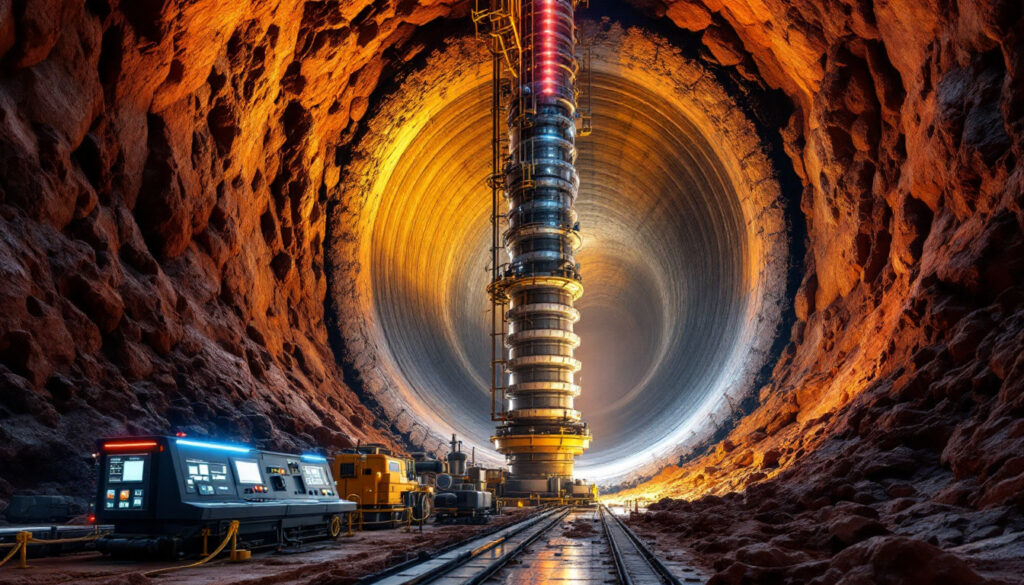What is Raise Bore Drilling in Australian Mining?
Raise bore drilling has revolutionized shaft development across Australia's mining landscape, offering a safer, more efficient alternative to conventional blasting methods. This specialized drilling technique creates vertical or near-vertical connections between underground levels by using a mechanical drilling process rather than explosive force.
The technique first gained popularity in Australia during the 1970s but has seen significant technological advancement in recent decades. Today, it stands as a cornerstone methodology for creating ventilation shafts, ore passes, and access ways in mining operations from Western Australia's iron ore fields to Queensland's coal mines.
According to industry data, over 60% of major underground mining operations in Australia now utilize raise bore technology for shaft development, representing a substantial shift from blasting-dependent methods of previous generations.
"Raise bore drilling has become the gold standard for developing shafts in Australian mining operations where safety, precision, and efficiency are paramount," explains Joshua Sugden, General Manager – Australasia at Master Drilling, which entered the Australian market in June 2020.
Since its entry, Master Drilling has established significant partnerships with Tier 1 miners in Australia, leveraging their global fleet of over 150 rigs and experience across 23 countries to elevate local standards for raise bore drilling in Australian mining.
How Does Raise Bore Drilling Work?
The Technical Process Explained
Raise bore drilling follows a methodical two-stage process that begins underground and works upward:
-
Pilot Hole Drilling: Engineers first drill a small-diameter pilot hole (typically 200-350mm) from an upper level downward to a lower level or from surface to underground.
-
Reaming Operation: Once the pilot hole breaks through to the target level, a reamer head is attached to the drill string at the lower level. The drilling rig then pulls the reamer upward, gradually enlarging the hole to the required diameter.
As the reamer rotates upward, it grinds away rock rather than shattering it with explosives. The cuttings simply fall to the lower level where they can be easily removed with conventional mucking equipment.
This approach creates smooth-walled, structurally sound shafts that often require minimal additional support compared to conventionally developed openings, particularly in competent rock conditions.
Key Equipment Requirements
Modern raise bore drilling operations rely on several sophisticated components:
- Raise Bore Machines: Powerful hydraulic drilling systems with thrust capacities ranging from 450kN to over 3,000kN for deeper applications
- Pilot Bits: Typically 9-12 inches in diameter, designed for directional stability and wear resistance
- Reaming Heads: Available in various configurations from 1.5m to 6m in diameter, equipped with replaceable cutting discs
- Drill Pipes: High-tensile steel rods that connect the surface equipment to the cutting tools
- Surveying Systems: Including gyroscopic and electronic deviation measurement tools achieving accuracy within 0.1% of depth
- Ground Support Systems: Including rock bolts, mesh, shotcrete applicators, and liner installation equipment
The technology continues to evolve, with recent innovations including remote operation capabilities that allow operators to control drilling processes from surface control rooms, dramatically reducing personnel exposure to underground hazards.
What Are the Primary Applications of Raise Bore Drilling?
Mine Ventilation Systems
Ventilation raises serve as the respiratory system of underground mines, allowing fresh air intake and exhaust of contaminated air. These critical passages typically range from 2.4m to 5m in diameter depending on airflow requirements.
In Australia's deepest mines, which now extend beyond 1,500 meters below surface, efficient ventilation becomes increasingly challenging. Well-designed raise bore ventilation systems can move over 400 cubic meters of air per second through a single shaft, providing essential cooling and contaminant removal.
"A properly engineered ventilation raise can make the difference between an economically viable deep mining operation and one that becomes prohibitively expensive due to supplementary cooling requirements," notes Sugden.
Ore Transfer Solutions
Ore passes created via raise boring provide gravity-assisted material transfer between different levels of a mine. These vertical chutes eliminate the need for trucks or conveyor systems to move material between levels, reducing both operational costs and energy consumption.
Studies from Australian mining operations indicate that gravity-assisted ore transfer systems can reduce mechanical transport costs by 15-30% compared to conventional haulage, while simultaneously decreasing diesel emissions underground.
Water Management Infrastructure
Australia's variable climate creates unique water management challenges for mining operations. Raise bore drilling creates essential infrastructure including:
- Dewatering shafts: Allowing pumping systems to remove groundwater efficiently
- Drainage holes: Preventing unwanted water accumulation in working areas
- Water supply bores: Providing process water to underground operations
These systems often incorporate specialized hydrostatic steel liners to prevent contamination of surrounding aquifers and ensure compliance with environmental regulations.
Emergency Escape Routes
Australian mining regulations mandate secondary egress options in all underground operations. Raise bored escape ways, typically equipped with ladderways or emergency hoisting systems, provide crucial alternative exits during emergencies.
The smooth, stable walls created by raise boring offer significant advantages for these safety-critical installations, reducing maintenance requirements and ensuring reliable access during emergencies.
What Are the Advantages of Raise Bore Drilling?
Enhanced Safety Benefits
Safety represents the primary advantage of raise bore drilling compared to conventional shaft sinking methods. The elimination of explosives removes numerous hazards:
- No blast-related risks: Including flyrock, premature detonations, and misfired charges
- Reduced vibration damage: Preventing destabilization of surrounding rock structures
- Elimination of post-blast fumes: Removing respiratory hazards associated with explosive residues
- Minimal personnel exposure: Remote operation keeps workers away from unsupported ground
These safety improvements translate into measurable outcomes. According to industry safety data, raise bore development projects report approximately 75% fewer safety incidents compared to conventional shaft sinking methods in similar ground conditions.
Increased Drilling Precision
Modern raise bore technology delivers exceptional accuracy, with advanced directional control systems achieving deviation tolerances as low as 1% of depth in favorable conditions.
This precision ensures shafts connect exactly where intended – a critical factor when linking existing underground workings or creating connections to surface infrastructure. Gyroscopic surveying tools provide real-time feedback on alignment, allowing engineers to make adjustments during the pilot hole phase before the more expensive reaming operation begins.
Reduced Environmental Impact
Environmental advantages include:
- Minimal surface disruption: Requiring smaller operational footprints than conventional methods
- Reduced waste production: Generating up to 40% less waste material than drill-and-blast approaches
- Lower noise levels: Operating at approximately 85dB compared to 110+dB for explosive-based methods
- Decreased dust emissions: Wet drilling techniques minimize airborne particulates
- Smaller carbon footprint: Reduced equipment requirements and shorter project timelines lower overall emissions
These environmental benefits make raise boring particularly valuable in environmentally sensitive areas or operations near population centers, where minimizing disturbance is a regulatory requirement.
Operational Efficiency Improvements
The continuous nature of raise boring delivers significant time and cost advantages:
- Faster completion: Projects typically finish 30-40% quicker than conventional methods
- Reduced labor requirements: Automated systems require fewer personnel
- Lower support costs: Smooth walls often need minimal additional reinforcement
- Decreased ventilation requirements: No blast fumes to clear between cycles
- Higher utilization rates: Equipment operates continuously rather than in blast-and-clear cycles
A typical 3.5m diameter, 350m ventilation raise might require 45-60 days using conventional methods but can be completed in 25-35 days with modern raise boring techniques, representing substantial time and cost savings.
What Challenges Does Raise Bore Drilling Present?
Technical Requirements and Limitations
Despite its advantages, raise boring has inherent limitations:
- Diameter constraints: Standard equipment typically handles maximum diameters of 6m
- Depth limitations: Most systems operate effectively to depths of 1,000-1,200m
- Starting chamber requirements: Need sufficient underground space for reamer assembly
- Specialized expertise: Operations require highly trained personnel with specific certifications
- High initial investment: Equipment costs exceed conventional drilling setup expenses
These factors must be carefully evaluated during project planning to determine if raise boring represents the optimal approach for specific applications.
Ground Condition Considerations
Geological factors significantly impact raise boring feasibility and execution:
- Rock competency: Highly fractured or incompetent ground may require pre-support
- Water ingress: Heavy groundwater flows can complicate operations
- Stress fields: High in-situ stresses may cause borehole instability or closure
- Variable lithology: Transitions between rock types can create deviation issues
- Methane presence: Gas-bearing formations require specialized monitoring and control measures
"Ground conditions represent the most significant variable in raise bore success," explains Sugden. "Comprehensive geotechnical analysis before drilling begins is absolutely essential to identify potential challenges and develop appropriate mitigation strategies."
A notable Australian case study involved a 30-meter weathered zone with significant methane and water ingress issues that required specialized ground consolidation techniques before successful raise boring could proceed.
Equipment and Expertise Availability
The specialized nature of raise boring creates resource challenges:
- Limited equipment availability: During mining booms, suitable rigs may be difficult to secure
- Expertise shortages: Qualified operators remain in high demand across Australian operations
- Long lead times: Specialized components often have extended procurement timelines
- Maintenance dependencies: Complex equipment requires specialized service technicians
- High mobilization costs: Transporting large rigs to remote sites involves significant expense
These constraints require early engagement with specialized contractors and careful alignment with project timelines to ensure equipment and expertise availability.
How is Master Drilling Advancing Raise Bore Technology in Australia?
Comprehensive Turn-Key Solutions
Since entering the Australian market in 2020, Master Drilling has established itself by offering integrated raise bore solutions rather than standalone drilling services. This comprehensive approach includes:
- Pre-drilling geotechnical investigations: Including core analysis and structural mapping
- Custom engineering design: Tailored to specific project requirements and ground conditions
- Complete project management: Single point of responsibility for the entire raise bore project
- Specialized ground support implementation: Including shotcreting and liner installation
- Quality assurance documentation: Detailed records of achieved specifications and performance
This end-to-end service model has proven particularly valuable for operators with limited in-house raise boring expertise, allowing them to access specialized capabilities without developing internal teams.
Technological Innovations
Master Drilling has introduced several technological advancements to the Australian market:
- Remote drilling capabilities: Operating raise bore equipment from surface control centers
- LiDAR scanning technology: Creating high-resolution 3D geological modelling of underground workings
- Real-time deviation monitoring: Allowing immediate corrective actions during pilot drilling
- Automated pipe handling systems: Reducing manual interaction with heavy components
- Integrated data analytics: Optimizing drilling parameters based on performance feedback
These innovations have significantly improved both safety outcomes and operational efficiency across Australian projects.
Ground Consolidation Expertise
One of Master Drilling's key differentiators lies in its ground consolidation capabilities, which include:
- Shotcrete application systems: Providing initial support in fractured ground conditions
- Pressure grouting techniques: Stabilizing surrounding rock and reducing water ingress
- Hydrostatic steel liner installation: Creating waterproof passages through aquifers
- Piling and integrated collar cap systems: Establishing stable foundations in weathered surface zones
- Post-drilling support implementation: Ensuring long-term stability of completed raises
This integrated approach to ground management has enabled successful completion of raise boring projects in geological conditions that would have previously been considered unsuitable for the technique.
Case Study: Overcoming Complex Geological Challenges
A recent Australian project highlighted Master Drilling's comprehensive approach to challenging conditions. The project encountered a 30-meter weathered zone with simultaneous methane gas and water ingress issues that threatened both stability and safety.
The solution involved:
- Detailed geotechnical analysis: Core sampling identified specific weakness zones
- Custom-engineered piling solutions: Providing collar stabilization through the weathered zone
- Live gas monitoring systems: Ensuring continuous risk management throughout operations
- Hydrostatic steel liner installation: Preventing water infiltration into the completed shaft
- Specialized grouting program: Consolidating fractured rock around the pilot hole path
This multi-faceted approach allowed successful raise bore completion in conditions that would have severely complicated conventional methods, demonstrating how integrated services can overcome significant technical challenges.
How is Raise Bore Drilling Evolving in Australian Mining?
Remote Operation Capabilities
The most significant evolution in raise boring involves the shift toward remote operations:
- Control center developments: Surface facilities that monitor and control underground equipment
- Automated drill pipe handling: Reducing personnel requirements for rod additions/removals
- Machine vision systems: Providing visual confirmation of underground conditions
- Telemetry innovations: Transmitting real-time performance data to surface
- Interconnected equipment platforms: Allowing synchronized operation of multiple systems
These advancements align with the broader mining innovation trends toward reduced personnel exposure to hazardous environments, improving both safety outcomes and operational consistency.
Integration with Digital Technologies
Raise boring operations increasingly leverage digital capabilities:
- Digital twin modeling: Creating virtual representations of raise bore projects for simulation
- Real-time monitoring systems: Tracking critical parameters including torque, weight, and rotation
- Predictive maintenance technologies: Identifying potential equipment issues before failures occur
- Ground condition modeling: Using geological data to optimize drilling parameters
- Performance analytics: Benchmarking efficiency against historical project data
Australian operations have been particularly quick to adopt these digital innovations, supported by the country's strong mining technology ecosystem and reliable connectivity infrastructure even in remote locations.
Adaptation to Deeper Mining Requirements
As Australian mines pursue deeper deposits, raise boring techniques continue to evolve:
- Higher-capacity equipment: Developing systems capable of reaching 1,500+ meter depths
- Enhanced ground control methods: Addressing increased stress at depth
- Thermal management solutions: Operating effectively in higher temperature environments
- Staged drilling approaches: Breaking longer raises into manageable sections
- Hybrid methodologies: Combining raise boring with other techniques for ultra-deep applications
These adaptations ensure raise boring remains viable as mines extend to depths where traditional methodologies face increasing challenges related to ground pressure, temperature, and logistical complexity.
What Safety Considerations Are Essential for Raise Bore Operations?
Risk Assessment Protocols
Comprehensive risk assessment forms the foundation of raise bore safety:
- Geotechnical uncertainty analysis: Identifying potential ground stability issues
- Equipment capability evaluation: Ensuring system suitability for specific applications
- Operator competency verification: Confirming personnel qualifications and experience
- Emergency scenario development: Planning responses to potential failure modes
- Regulatory compliance review: Ensuring alignment with state-specific mining regulations
Australian mining regulations mandate documented safety management systems for all raise bore projects, with specific requirements varying by state jurisdiction.
Monitoring Systems Implementation
Modern operations implement multilayered monitoring:
- Ground movement detection: Extensometers and convergence measuring devices
- Gas level monitoring: Continuous sampling for methane and other hazardous gases
- Equipment performance tracking: Load, torque, and hydraulic pressure sensors
- Water inflow measurement: Flow meters and pump performance monitoring
- Structural integrity verification: Regular inspection of support systems
These monitoring systems feed into integrated control platforms that provide operators with comprehensive situational awareness and early warning of developing issues.
Emergency Response Planning
Despite improved safety profiles, robust emergency protocols remain essential:
- Equipment failure procedures: Including mechanical backup systems and manual intervention options
- Ground collapse contingencies: Secondary access routes and rescue capabilities
- Water inrush management: Pumping capabilities and personnel evacuation plans
- Communication redundancy: Multiple systems for maintaining contact with underground teams
- Medical emergency responses: Including extraction plans for injured personnel
Regular emergency drills ensure all team members understand their roles during potential incidents, maintaining readiness despite the infrequent nature of serious emergencies in modern raise bore operations.
FAQ About Raise Bore Drilling in Australian Mining
How does raise bore drilling compare to conventional shaft sinking in terms of cost?
While initial equipment costs are higher, raise boring typically offers 15-30% overall cost savings through faster completion times, reduced labor requirements, and minimal ground support needs in favorable conditions. A typical 3.5m diameter, 300m ventilation shaft might cost approximately AUD 2.5-3.5 million using raise bore methods compared to AUD 3.5-4.5 million using conventional sinking, though actual costs vary significantly based on specific project conditions.
What are the typical diameters achieved with raise bore drilling in Australian mines?
Most operational raise bores in Australian mines range from 1.5 to 4 meters in diameter, with ventilation raises typically 2.4-3.5m and ore passes 1.8-2.4m. Specialized equipment can achieve diameters up to 6 meters in suitable ground conditions, though projects exceeding 4m diameter represent less than 15% of total raise boring activity in Australia due to equipment limitations and ground stability considerations.
How does the Australian climate affect raise bore drilling operations?
Australia's varied climate presents unique challenges across different mining regions:
- Tropical North: High rainfall creates significant water management issues requiring enhanced pumping capabilities and water-resistant electrical systems
- Arid Interior: Extreme temperature fluctuations affect hydraulic system performance an
Want to Identify the Next Major Mineral Discovery?
Discover how significant ASX mineral discoveries can generate substantial returns by exploring Discovery Alert's dedicated discoveries page, where our proprietary Discovery IQ model delivers real-time alerts that transform complex mineral data into actionable investment insights.




